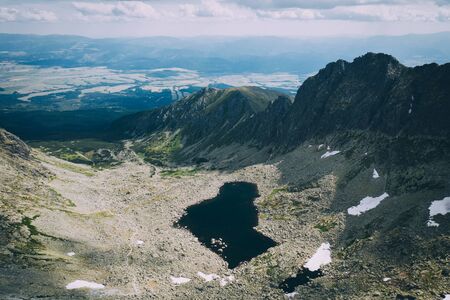Introduction: Embarking on a Sacred Adventure
The rugged coastline and rolling green hills of North Wales have long captivated travellers, but for centuries, this landscape has also been the backdrop to a uniquely spiritual journey. The North Wales Pilgrims Trail weaves through ancient villages, along windswept shores, and across wild headlands, tracing footsteps left by generations of seekers in search of solace and meaning. At the trail’s westernmost point lies Bardsey Island—Ynys Enlli in Welsh—a small, weather-beaten isle that has earned its hallowed reputation as the Island of 20,000 Saints. This pilgrimage is more than a scenic walk; it is an immersion into the deep spiritual heritage that defines this region. From early Celtic Christianity to the enduring legends of saints and miracles, the path to Bardsey invites modern pilgrims to reflect on faith, tradition, and the awe-inspiring beauty of sacred landscapes.
2. Pilgrims’ Pathways: Tracing Ancient Footsteps Across North Wales
The journey to Bardsey Island, or Ynys Enlli as it is known in Welsh, has been a pilgrimage for centuries, deeply rooted in the region’s spiritual and cultural history. These ancient trails crisscross North Wales, weaving through valleys, coastal paths, and rugged hills. They not only connect physical landmarks but also the stories and legends of countless pilgrims who walked before us. The routes are marked by a series of churches, holy wells, and traditional waymarks, each echoing the footsteps of medieval travellers seeking solace and spiritual fulfilment.
Among the most significant waypoints are the historic churches that dot the landscape. Many were founded by Celtic saints and served as crucial rest stops or places of worship along the pilgrim route. For instance, St. Beuno’s Church in Clynnog Fawr stands as a testament to this enduring tradition; its ancient stone walls have sheltered generations of seekers making their way westward. Local legends tell of miracles performed here, adding layers of meaning to every stone and corner.
Waymarks are another integral feature guiding pilgrims across North Wales. Traditionally carved stones or simple wooden posts, these markers blend seamlessly into the countryside yet offer reassurance that one is following an age-old path. Today, modern signs often accompany these relics, combining heritage with practicality for contemporary walkers.
| Landmark | Location | Historical Significance |
|---|---|---|
| St. Beuno’s Church | Clynnog Fawr | Main gathering point for pilgrims en route to Bardsey Island; site linked with miracles |
| St. Hywyn’s Church | Aberdaron | Final mainland stop before crossing to Bardsey Island; 13th-century origins |
| Bardsey Island Abbey Ruins | Bardsey Island | Resting place of saints; considered one of Britain’s holiest sites |
| Pilgrims’ Well (Ffynnon Fair) | Llanfair | Sacred spring believed to have healing powers for weary travellers |
The trails themselves are steeped in local myth and folklore—stories of saintly deeds, miraculous cures, and even supernatural encounters enliven the landscape. Walking these paths today is not just a physical journey but an immersion into Welsh heritage, where every step resonates with echoes from the past.

3. Welsh Landscapes: Embracing Nature and Culture
As pilgrims set out along the North Wales Pilgrims Trail towards Bardsey Island, they find themselves enveloped by an ever-changing patchwork of landscapes that are quintessentially Welsh. The journey begins amidst rolling green hills dotted with grazing sheep, their gentle bleats forming a soundtrack to the countryside. Hedgerows heavy with wildflowers edge narrow lanes, while ancient dry-stone walls trace the contours of the land, silent witnesses to centuries of rural life. With each step westward, the scenery shifts—lush woodlands give way to windswept uplands and dramatic coastal cliffs, offering expansive views across Cardigan Bay. Wildlife is abundant; red kites wheel overhead, while skylarks serenade travellers from above. Pilgrims often pause to admire clear mountain streams or catch glimpses of shy foxes darting through gorse bushes. The rural charm is further amplified by the presence of small villages where stone cottages huddle around medieval churches, and locals greet visitors with a warm “croeso.” Here, tradition runs deep—Welsh language fills the air, and the rhythms of farming life continue much as they have for generations. This harmonious blend of nature and culture not only nourishes the spirit but also roots pilgrims in a living landscape shaped by faith and community.
4. Community and Hospitality: Meeting Local People
One of the most memorable aspects of walking the North Wales Pilgrims Trail to Bardsey Island is the genuine warmth extended by the communities along the way. Welsh hospitality, or “Croeso Cymreig”, is not just a phrase; it’s a living tradition that weaves together local culture, language, and everyday kindness. As you make your way from ancient churches to windswept coastal villages, encounters with local people offer more than just a friendly chat—they provide insight into a distinctive way of life shaped by centuries of pilgrimage and close-knit community bonds.
The Spirit of Croeso: Welsh Welcoming Traditions
Welsh communities are renowned for their open-heartedness towards travellers and pilgrims alike. It’s common to be greeted with a warm “Bore da” (Good morning) or “P’nawn da” (Good afternoon) in shops, pubs, and chapels. Many local establishments—ranging from family-run B&Bs to traditional inns—go out of their way to make visitors feel at home. Sharing stories over a cup of tea or a pint of locally brewed ale is all part of the experience, reinforcing the sense that you’re not merely passing through, but becoming a temporary part of the community fabric.
Tradition and Language: A Living Heritage
As you journey westward, you’ll notice the rich tapestry of Welsh language and customs that define each settlement along the trail. Road signs, shopfronts, and chapel boards are often bilingual, reflecting the proud preservation of Welsh identity. In some villages, especially closer to Bardsey Island, Welsh is spoken as readily as English, offering an authentic immersion into local culture. Don’t hesitate to try out simple phrases—locals appreciate any effort to engage with their language.
Common Welsh Phrases on the Pilgrims Trail
| English | Welsh | When to Use |
|---|---|---|
| Hello | Helo | Upon meeting someone new |
| Thank you | Diolch | After receiving help or service |
| Please | Os gwelwch yn dda | Making requests in shops or cafes |
| Goodbye | Hwyl fawr | When departing from company |
| Cheers! | Iechyd da! | Raising a glass in a pub or gathering |
The Role of Local Customs and Gatherings
Pilgrims often find themselves invited to chapel services, village fêtes, or spontaneous gatherings where music plays a central role—choirs singing traditional hymns or local musicians performing folk tunes on harp and fiddle. These moments highlight how faith, music, and community spirit remain deeply intertwined in rural Wales.
A Blend of Old and New
The welcoming nature isn’t limited to tradition alone; many communities along the trail have adapted to modern walkers’ needs without losing their heritage. You might stumble upon pop-up cafés in church halls, eco-friendly accommodation options run by locals, or art exhibitions celebrating both ancient legends and contemporary creativity. This harmonious blend of past and present ensures every encounter along the Pilgrims Trail feels both rooted and refreshingly unique.
5. Bardsey Island: Mysticism at the Edge of the Sea
Reaching Bardsey Island, or Ynys Enlli in Welsh, marks a climactic moment on the North Wales Pilgrims Trail. The final leg of the journey—often crossing the narrow but unpredictable Bardsey Sound—carries an air of anticipation and awe, heightened by stories whispered through generations. As one steps onto this small, rugged island, there is an immediate sense of tranquility, shaped by centuries of spiritual significance and natural isolation. Bardsey’s reputation as “the island of 20,000 saints” is rooted in its history as a medieval pilgrimage site; it was believed that three pilgrimages to Bardsey equalled one to Rome in merit. The presence of ancient monastic ruins and the iconic lighthouse stand as reminders of the island’s layered past.
Sanctity Intertwined with Nature
Bardsey’s sacredness is inseparable from its wild landscape. The wind-swept heathland, seabird colonies, and rare flora contribute to an almost otherworldly peace that visitors immediately notice. Many pilgrims report a profound sense of stillness here, whether sitting quietly by the shore or exploring the remnants of St Mary’s Abbey. This serenity is not merely aesthetic; it offers space for reflection, prayer, or silent appreciation—a tradition continued by modern visitors and retreat-goers who seek respite from life’s clamour.
Legends and Living Heritage
The island is steeped in myth and legend. Some say King Arthur himself rests here among the saints. Oral histories passed through local communities add to this enigmatic allure, blending Christian lore with older Celtic traditions. Today, Bardsey remains a living place of pilgrimage: annual crossings see walkers and spiritual seekers alike coming together, often welcomed by the resident community dedicated to preserving the island’s heritage and peaceful environment.
A Spiritual Destination Beyond Time
To arrive at Bardsey Island is to step into a liminal space where history, faith, and nature converge. Its mysticism endures not only in relics and stories but also in the quiet moments experienced on its shores—moments which continue to draw those searching for meaning or simply wishing to stand on the edge of the sea, enveloped by a sense of timeless sanctity.
6. Practical Notes: Planning Your Pilgrimage
Embarking on the North Wales Pilgrims Trail to Bardsey Island is an inspiring adventure, but a bit of practical preparation will ensure your journey is as rewarding as it is memorable. Below, youll find guidance on navigation, accommodation, weather considerations, and general tips for those setting out along this historic route.
Navigation: Following the Footsteps
The Pilgrims Trail is well-signposted with distinctive shell markers, but its always wise to carry an up-to-date Ordnance Survey map (Explorer OL17 and OL18 cover most of the route). A GPS device or a reliable mobile app like OS Maps can be invaluable, particularly in areas where the path might become indistinct due to weather or farming activity. The route traverses a mix of coastal paths, farmland, and ancient lanes—be prepared for some rugged terrain and keep an eye out for traditional waymarkers at key junctions.
Accommodation: Where to Rest Your Head
The trail passes through welcoming Welsh villages such as Bangor, Caernarfon, Pwllheli, and Aberdaron. Accommodation options range from cosy B&Bs and traditional inns to campsites for those who prefer sleeping under canvas. Booking ahead is strongly recommended, especially during summer or school holidays when local spots fill up quickly. Many establishments along the trail are familiar with pilgrims and offer facilities such as boot rooms and packed lunches.
Weather: Expecting the Unexpected
North Wales weather can be famously unpredictable. Even in summer, you may encounter four seasons in a single day. Pack waterproofs and layers; breathable fabrics will serve you well. Good boots are essential—the paths can become muddy after rain. Always check the local forecast before setting out each day, especially if youre planning the crossing to Bardsey Island, which is highly dependent on sea conditions.
Guidance for Modern-Day Pilgrims
Respecting Local Customs
The North Wales Pilgrims Trail passes through close-knit communities with deep-rooted traditions. A friendly “bore da” (good morning) or “diolch” (thank you) in Welsh goes a long way. Be mindful of livestock gates—leave them as you find them—and stick to marked paths.
Pilgrim Passports & Personal Reflections
Many choose to collect stamps in a pilgrim passport available from churches en route—a lovely keepsake marking your progress. Take time for personal reflection; many churches along the way are open for quiet contemplation regardless of religious affiliation.
Reaching Bardsey Island
The final leg involves a boat crossing from Porth Meudwy near Aberdaron to Bardsey Island. Boats run seasonally and are weather-dependent; booking ahead is essential. Allow flexibility in your schedule should crossings be delayed by rough seas.
With thoughtful preparation, the North Wales Pilgrims Trail offers not just sacred scenery but an opportunity for profound connection—with heritage, landscape, and fellow travellers alike.
7. Reflections: Personal Insights from the Pilgrims’ Trail
Walking the North Wales Pilgrims Trail to Bardsey Island is far more than a physical journey; it is an experience that quietly transforms the soul. As I completed each stage, the ancient landscapes and gentle rhythm of rural Wales offered rare moments of stillness and introspection. The winding lanes, stone chapels, and salt-laden breezes became companions in my search for meaning, echoing the footsteps of countless pilgrims before me.
The act of pilgrimage—travelling with intention, open to whatever may come—invites a deep sense of humility. There is something profoundly grounding about tracing these historic paths, feeling the weight of centuries beneath your boots. Along the way, conversations with locals over tea or a pint in a village pub remind you that pilgrimage is as much about community as solitude. The stories shared, both ancient and modern, knit together a tapestry of faith, doubt, hope, and belonging unique to North Wales.
Arriving at Bardsey Island itself—Ynys Enlli, the ‘Island of 20,000 Saints’—brings a quiet culmination. Looking across the water to this sacred outcrop at land’s end, I found space for reflection that is hard to come by in everyday life. For many, reaching Bardsey is not just about crossing miles but about shedding burdens carried from home, making peace with the past, or simply finding clarity in the wild beauty of the Welsh coast.
This trail taught me that pilgrimage need not be grand or overtly religious; it can be an honest search for meaning amid uncertainty. The slow pace fosters gratitude for small things—a birdcall in a hedgerow, sunlight on lichen-streaked stones, or laughter shared between strangers-turned-friends. In its quiet way, North Wales offers healing: a reminder that we are all part of something older and greater than ourselves.
For anyone considering undertaking this journey, I would say: come with open eyes and an open heart. Let the landscape speak to you; let silence have its say. Whether you seek spiritual renewal or simply time away from the demands of modern life, the Pilgrims Trail to Bardsey Island promises more than just scenic views—it offers a chance to reconnect with yourself and with Britain’s enduring spirit of pilgrimage.


